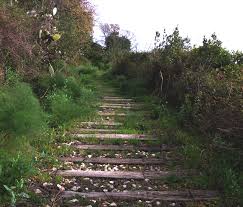At SS114, at the entrance of Acireale, take the road that descends towards S. Tecla. After about 300 meters from the traffic light, the beginning of the track, which is hard to identify, opens on the left and faces Via Malascesa. Some short, steep curves give you access to the old track of an abandoned railway, which is characterized by three sections of the tunnel. We cross part of the small Temba (Tempe del Belfortizio and Timba Falconera) which offers wide views of majestic canyons and magnificent panorama of the coast in a region rich in magnificent plants. Alternate small slices of heat-loving forests with vergilian oak with Mediterranean scrub and lemon "gardens", traditional crops in the area. On the rocky hills and along the way, you can see the tree Euphorbia, a semi-spherical shrub, adapted to the long drought, losing its leaves in the summer months to submerge itself with green spaces that begin in autumn. The human fingerprint is found by observing some exotic natural gems: Fico d'India and Ailanto, which are found in Timpa's natural vegetation.
Along this route, it is possible to observe Gyandia, Jibu and Buyana during flight.
The first part of the road is quite inconvenient because the track is partially linked by the Rufiti. In this section, we encountered a cave visible to the right and to the left of the path. These caves are composed of a lava tunnel, an insulated pipeline that allows lava to reach large distances from the emission point. When lava subsides in its outer parts, it creates solid side banks that come together to form a ceiling. The composition of the cave is connected by emptying the lava tunnel that can occur during or at the end of the eruption. This cave offers a remarkable development and is characterized by the presence of typical lava coils at the base of the walls resulting from the sudden cooling of the inner part of the lava tunnel and subsequent separation from a wall of lava sheet that curls at the base. Continuing, you encounter the first tunnel, from this point on the road becomes easy and free of obstacles. The extension in the tunnel was interrupted by wide grooves that eroded rocky hills. From time to time, the galleries offer spectacular observation points where you can enjoy a wide view of the Ionian coast and the Timpa of Santa Tecla, a large flat area with citrus groves, consisting of sea terraces and depressions filled with plains and landslides.
The latest exhibition, with a total development of 468 meters, is the longest and most impressive. On the foundation stone is engraved year finished construction work in this charming extension of the railway: 1912. The constructive quality of the building is fascinating, which is intact after more than a century. The interior of the galleries is completely covered with lava stone, in addition to decorating the basement, performs a fixed function important. He bypassed the tunnels and continued all the way until you reached the gate. In this latter sector, the shelf is loosened by a broad band with a lighter tendency, consisting of historical lava flows.



